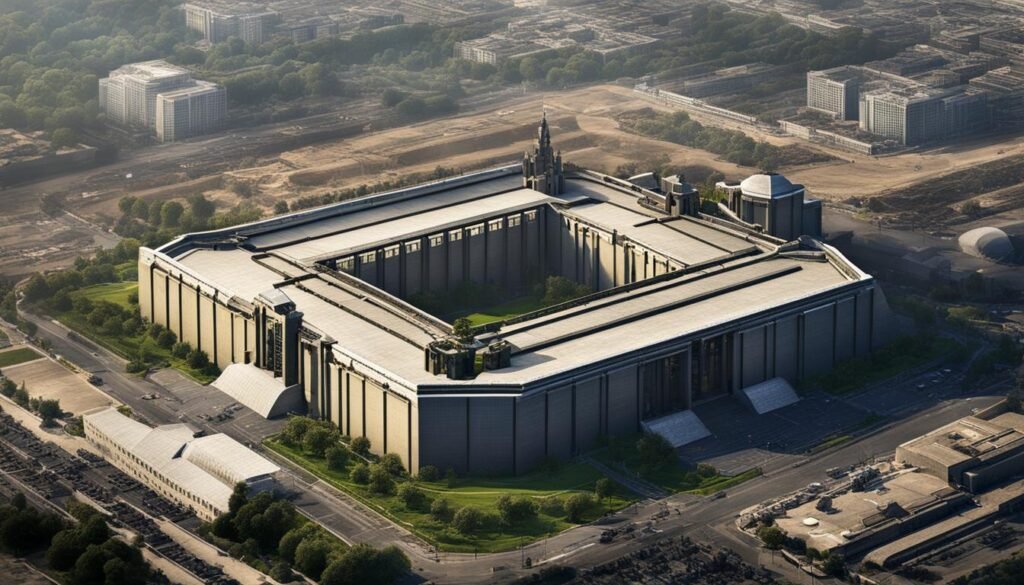The importance of security architecture cannot be overstated in today’s digital landscape. With cyber threats on the rise and the cost of cybercrime projected to reach trillions of dollars, organizations must prioritize information security to protect their assets and sensitive data. This is where security architecture comes into play.
Security architecture involves the implementation of various security controls to safeguard organizations from cyber threats. These controls include encryption, access controls, and secure communication channels. By adhering to the principles of security architecture such as confidentiality, integrity, availability, authentication, authorization, auditing and logging, network security, application security, incident response, and security governance, organizations can establish a robust and comprehensive framework for protecting their information.
Key Takeaways:
- Security architecture is crucial for safeguarding organizations from cyber threats.
- Implementation of security controls, such as encryption and access controls, is essential.
- The principles of security architecture include confidentiality, integrity, availability, authentication, authorization, auditing and logging, network security, application security, incident response, and security governance.
- By considering these principles, organizations can design and implement a comprehensive security architecture framework.
- Understanding and implementing security architecture is vital to protect sensitive information and mitigate cybersecurity risks.
Key Components of Security Architecture
Security architecture encompasses various components that work together to protect an organization’s sensitive information and prevent unauthorized access. These components include:
- Confidentiality: To ensure confidentiality, encryption, access controls, data classification, and secure communication channels are implemented. These measures safeguard sensitive data from unauthorized disclosure.
- Integrity: Maintaining data integrity involves implementing data validation techniques, such as checksums and digital signatures, to ensure that information remains unchanged and accurate. Audit trails also play a crucial role in monitoring and maintaining data integrity.
- Availability: Robust network infrastructure, redundancy, fault tolerance mechanisms, and disaster recovery plans contribute to the availability of resources and services. These measures ensure that essential systems and data are accessible to authorized users at all times.
- Authentication: Authentication mechanisms verify the identities of users and systems. Strong passwords, multi-factor authentication, biometrics, and secure protocols are employed to validate and authenticate user credentials.
- Authorization: Authorization components determine access rights based on roles and responsibilities within the organization. By assigning appropriate permissions, authorization ensures that only authorized individuals can access specific resources and perform certain actions.
- Auditing and Logging: Auditing and logging practices monitor and track security events and incidents. This includes recording access attempts, system changes, and other security-related activities. Auditing and logging play a vital role in detecting and investigating security breaches.
- Network Security: Network security components include firewalls, intrusion prevention systems (IPS), virtual private networks (VPNs), network segmentation, and the implementation of secure protocols. These measures protect the organization’s network infrastructure from external threats.
- Application Security: Application security focuses on securing software and applications. Secure coding practices, vulnerability assessments, penetration testing, and web application firewalls are employed to address vulnerabilities and protect against attacks targeting applications.
By incorporating these key components into their security architecture, organizations can create a robust and comprehensive framework to safeguard their information and systems.
Security Architecture Frameworks
When it comes to designing an effective security architecture, organizations can rely on established frameworks that provide structured approaches and best practices. These frameworks guide the development and implementation of security measures, ensuring robust protection against cyber threats.
1. TOGAF (The Open Group Architecture Framework)
TOGAF is a prominent framework that integrates security considerations throughout the enterprise architecture development process. It enables organizations to align security objectives with business goals, ensuring a comprehensive and holistic approach to security architecture. By following the TOGAF framework, organizations can implement a well-defined and standardized security architecture.
2. SABSA (Sherwood Applied Business Security Architecture)
SABSA focuses specifically on security architecture and risk management. It emphasizes aligning security objectives with the organization’s overall strategic goals and governance structure. SABSA enables the development of a tailored security architecture that addresses specific business needs, ensuring that security measures are implemented in a risk-based and efficient manner.
3. OSA (Open Security Architecture)
OSA offers architectural patterns and best practices for addressing common security challenges. It provides a library of reusable security components, allowing organizations to accelerate the development and deployment of their security architecture. OSA guides the implementation of effective security controls and measures to safeguard critical systems and information.
In addition to these frameworks, there are other widely recognized standards and frameworks that organizations can consider, such as the NIST Cybersecurity Framework, ISO 27001, PCI-DSS, HIPAA, SOC 2, and Zero Trust Security Principles. The choice of framework depends on the organization’s specific needs, existing architectural practices, and compliance requirements.
Furthermore, as organizations increasingly embrace cloud computing, a specialized framework known as cloud security architecture comes into play. Cloud security architecture encompasses the design and implementation of security measures in cloud environments. This includes identity and access management, data encryption, network security, and incident response strategies tailored to the unique challenges and requirements of cloud computing.
By leveraging security architecture frameworks like TOGAF, SABSA, and OSA, organizations can establish a robust security foundation that mitigates risks, ensures compliance, and protects against cyber threats.
Business Security Architecture

Business security architecture plays a crucial role in protecting an organization’s assets, operations, and stakeholders. By designing and implementing effective security controls, businesses can mitigate risks and ensure the confidentiality, integrity, and availability of sensitive information.
Key components of business security architecture:
- Risk Assessment: Conducting thorough risk assessments to identify vulnerabilities and potential threats.
- Security Policies: Developing and implementing comprehensive security policies that outline the organization’s security objectives and guidelines.
- Asset Protection: Implementing access controls, encryption, and physical security measures to protect valuable assets.
- Network Security: Establishing robust network security measures, including firewalls, intrusion prevention systems, and secure protocols.
- Application Security: Implementing secure coding practices, vulnerability assessments, and web application firewalls to safeguard against application-level attacks.
Additionally, security awareness and training programs are essential to educate employees about security best practices and ensure their active involvement in maintaining a secure environment.
A comprehensive business security architecture not only protects an organization from cyber threats but also instills confidence among customers, partners, and stakeholders. It demonstrates the organization’s commitment to data privacy, compliance with regulations, and the proactive mitigation of security risks.
To provide a better understanding, here’s a table summarizing the key components of business security architecture:
| Component | Description |
|---|---|
| Risk Assessment | Identifying vulnerabilities and potential threats through systematic evaluations. |
| Security Policies | Establishing guidelines and procedures to ensure consistent security practices. |
| Asset Protection | Implementing measures to safeguard valuable assets from unauthorized access or theft. |
| Network Security | Securing the network infrastructure to protect against external attacks and unauthorized access. |
| Application Security | Implementing measures to protect applications from vulnerabilities and unauthorized access. |
| Security Awareness and Training | Educating employees about security best practices and promoting a culture of security within the organization. |
By integrating these components into their overall security strategy, businesses can establish a robust and resilient security architecture that effectively safeguards their operations and protects their valuable assets.
Benefits of Security Architecture

Implementing a strong security architecture offers numerous benefits to organizations, providing comprehensive protection and mitigating risks. By addressing vulnerabilities and reducing the risk of successful attacks, organizations can safeguard their sensitive information and maintain regulatory compliance.
“A well-designed security architecture enables organizations to demonstrate trustworthiness and mitigate potential disciplinary measures in the event of a breach.”
One of the key advantages of security architecture is its ability to save costs by enabling proactive measures. By detecting and fixing vulnerabilities early in the development cycle, organizations can avoid costly security breaches and potential reputational damage.
Furthermore, security architecture promotes increased resilience and business continuity. By implementing robust security measures, organizations can ensure the availability of their systems and minimize disruptions caused by security incidents.
Improved stakeholder confidence is another important benefit of security architecture. With a comprehensive security framework in place, organizations can demonstrate their commitment to protecting sensitive information and the privacy of their customers.
In summary, security architecture provides comprehensive protection, risk mitigation, regulatory compliance, increased resilience, business continuity, and improved stakeholder confidence. By optimizing security investments and ensuring scalability and adaptability, organizations can effectively protect their valuable assets.
See the table below for a comparison of the benefits of security architecture:
| Benefit | Description |
|---|---|
| Comprehensive protection | Addresses vulnerabilities and reduces the risk of successful attacks |
| Risk mitigation | Increases the resilience of systems and minimizes the impact of security incidents |
| Regulatory compliance | Helps organizations meet industry standards and demonstrate trustworthiness |
| Increased resilience | Enables systems to withstand security incidents and maintain business continuity |
| Business continuity | Minimizes disruptions and ensures the availability of critical operations |
| Improved stakeholder confidence | Instills trust in customers, partners, and investors |
By leveraging the benefits of security architecture, organizations can build robust defenses, protect their sensitive information, and ensure the continuity of their business operations.
Security Architecture Deliverables

Security architecture deliverables play a crucial role in designing and implementing effective security frameworks for organizations. These deliverables vary depending on the architect, the frameworks employed, and the specific objectives of the organization.
When utilizing the TOGAF (The Open Group Architecture Framework) methodology, security architecture deliverables may include:
- Business principles: A set of guiding principles that govern the organization’s approach to security.
- Security architecture roadmaps: Comprehensive plans outlining the organization’s security goals and strategies.
- Building blocks: Modular components that are combined to create a cohesive security architecture.
- Security architecture requirements: Detailed specifications for the desired security architecture.
On the other hand, SABSA (Sherwood Applied Business Security Architecture) deliverables focus specifically on security architecture and risk management. Some of these deliverables include:
- Business attribute model: A representation of the organization’s security needs and objectives.
- Security strategy: A plan that aligns security objectives with business goals and governance.
- Security policy architecture: A framework that outlines security policies and their enforcement mechanisms.
- Defined security services: Clear definitions of the services provided by the organization’s security architecture.
Lastly, OSA (Open Security Architecture) deliverables focus on technical security controls and software and data integrity protection. These deliverables may include:
- Technical security controls: Detailed specifications and configurations of the security controls implemented.
- Software and data integrity protection: Measures implemented to ensure the integrity of software and data.
These various security architecture deliverables are instrumental in helping organizations define their security objectives, plan for the target security architecture, meet compliance requirements, and specify the necessary security requirements for their systems and infrastructure.
Securing Information in the Cloud with Cloud Security Architecture

Cloud security architecture plays a crucial role in protecting sensitive information in a cloud computing environment. By designing and implementing robust security measures, organizations can safeguard their data, ensure availability, and maintain compliance with relevant regulations.
One of the key components of cloud security architecture is identity and access management (IAM). This involves establishing controls and processes to authenticate and authorize users, ensuring that only authorized individuals can access and modify data within the cloud environment.
Another essential aspect of cloud security architecture is data encryption. This involves encrypting data both at rest and in transit, making it unreadable and unintelligible to unauthorized individuals. Encryption adds an extra layer of protection to sensitive information, reducing the risk of data breaches and unauthorized access.
Network security is also a critical consideration in cloud security architecture. By implementing robust network security measures such as firewalls, intrusion detection systems, and virtual private networks (VPNs), organizations can protect their cloud infrastructure from malicious activities and unauthorized access.
Furthermore, cloud security architecture includes establishing incident response plans to effectively and efficiently address security incidents. These plans outline the steps and processes to be followed in the event of a security breach or incident, ensuring a swift response and minimizing the impact on the organization.
With the increasing focus on data privacy and protection, compliance is an integral part of cloud security architecture. Organizations must adhere to relevant regulations, industry standards, and best practices to maintain compliance. This includes implementing appropriate security controls, conducting regular audits, and ensuring data protection measures are in place.
Overall, cloud security architecture is essential for organizations leveraging cloud computing to secure their data and operations. By implementing robust identity and access management, data encryption, network security, incident response plans, and compliance measures, organizations can protect their valuable information and ensure the integrity and availability of their cloud environments.
| Component | Best Practices |
|---|---|
| Identity and Access Management | Implement strong authentication mechanisms, role-based access controls, and regular access reviews. |
| Data Encryption | Encrypt sensitive data at rest and in transit using industry-standard encryption algorithms. |
| Network Security | Deploy firewalls, intrusion detection systems, and secure network segmentation to protect cloud infrastructure. |
| Incident Response | Develop and test incident response plans, with clearly defined roles, responsibilities, and communication channels. |
| Compliance | Adhere to relevant regulations, industry standards, and frameworks to ensure data privacy and protection. |
By following these best practices, organizations can enhance their cloud security architecture and protect their valuable information from cyber threats and unauthorized access.
Security Architecture for Information Preservation

Security architecture plays a critical role in safeguarding sensitive data and ensuring its preservation. By designing and implementing robust security systems and controls, organizations can effectively protect their valuable information assets. Key components of security architecture include security policies and standards, risk assessment and management, security controls and technologies, network segmentation, identity and access management, incident response, and compliance measures.
Security policies and standards serve as guidelines for defining and enforcing security measures within an organization. They outline protocols and procedures that need to be followed to maintain the confidentiality, integrity, and availability of sensitive data. These policies also specify the responsibilities of employees and establish the framework for information protection.
Risk assessment and management are crucial in assessing potential threats and vulnerabilities to the organization’s information assets. By conducting risk assessments, organizations can identify and prioritize risks, enabling them to implement appropriate security controls and countermeasures. This proactive approach helps mitigate potential risks before they materialize.
Security controls and technologies provide the necessary mechanisms to protect information from unauthorized access, disclosure, and alteration. This includes implementing access controls, encryption, firewalls, intrusion detection systems, and other security measures to safeguard sensitive data. By aligning security controls with the organization’s risk profile, potential threats can be effectively mitigated.
Network segmentation, another important aspect of security architecture, involves dividing the organization’s network into smaller, isolated segments. This enhances security by limiting lateral movement of threats within the network, reducing the scope of potential data breaches.
Identity and access management (IAM) ensures that only authorized individuals can access sensitive information. IAM solutions authenticate user identities, enforce strong password policies, and provide tools for managing user access privileges. This helps prevent unauthorized access and ensures the integrity of data.
Incident response is an essential component of security architecture, involving predefined plans and procedures to handle security incidents. With a well-defined incident response framework, organizations can effectively detect, respond to, and recover from security breaches, minimizing the potential impact on information assets.
Compliance measures are essential to ensure adherence to relevant industry regulations and standards. By implementing security controls that meet compliance requirements, organizations can avoid costly penalties and reputational damage.
Overall, by considering these key aspects of security architecture, organizations can establish a robust framework for information preservation. This framework helps safeguard sensitive data, maintain its integrity, and ensure its accessibility to authorized individuals.
| Key Components of Security Architecture for Information Preservation |
|---|
| Security Policies and Standards |
| Risk Assessment and Management |
| Security Controls and Technologies |
| Network Segmentation |
| Identity and Access Management |
| Incident Response |
| Compliance Measures |
The Importance of Security Architecture and Important Factors
Security architecture plays a crucial role in protecting organizations’ valuable assets, mitigating security threats, and ensuring compliance with regulations. By implementing a comprehensive security architecture framework, organizations can achieve a robust and effective security posture. The objectives of security architecture encompass several key aspects:
- Ensuring the security, integrity, and accessibility of information assets: Security architecture aims to safeguard sensitive information from unauthorized access, modification, or disclosure. It involves implementing robust security controls, such as encryption, access controls, and data classification.
- Evaluating potential threats and vulnerabilities: Risk assessment is a fundamental part of security architecture. By assessing the organization’s overall risk landscape, potential threats and vulnerabilities can be identified and addressed effectively.
- Implementing security controls and countermeasures: Security controls are put in place to mitigate identified risks. These controls can include intrusion detection systems, firewalls, antivirus software, and security awareness training for employees.
- Creating a defense-in-depth plan: A defense-in-depth strategy involves applying multiple layers of security controls to protect against various attack vectors. This approach enhances the organization’s overall security resilience.
- Enabling efficient incident response and recovery: Security architecture includes designing incident response plans and implementing mechanisms for quick detection, containment, and recovery from security incidents. This ensures a timely and effective response to minimize the impact of any security breaches.
- Maintaining compliance: Compliance with industry regulations and standards is a critical objective of security architecture. By aligning security practices with compliance requirements, organizations can avoid penalties and maintain the trust of customers and stakeholders.
When designing a security architecture, several important factors should be considered:
- Scalability: The security architecture should be designed to accommodate the organization’s growth and evolving security needs.
- Flexibility: The architecture should be adaptable to changing technologies, threats, and regulatory requirements.
- Collaboration: Collaboration between security teams, IT departments, and stakeholders is essential for effective security architecture implementation.
- Continuous monitoring: Monitoring and assessment of security controls and systems should be an ongoing process to identify potential vulnerabilities and ensure their timely resolution.
- Continuous improvement: Security architecture should be continuously reviewed and improved based on the organization’s evolving security landscape and emerging threats.
By prioritizing these factors and goals, organizations can establish a robust security architecture that provides comprehensive protection, mitigates risks, and ensures the confidentiality, integrity, and availability of their valuable information assets.
Also Read : Understanding Types Of Assessments In Education
Conclusion
In today’s rapidly evolving digital landscape, incorporating a robust security architecture is paramount for organizations to safeguard their sensitive information and ensure secure business operations. By implementing a comprehensive security architecture framework, organizations can achieve comprehensive protection, effectively mitigate risks, ensure regulatory compliance, improve resilience and business continuity, enhance stakeholder confidence, and save costs.
Security architecture serves as a vital component of an organization’s overall security strategy, enabling the establishment of strong security controls and countermeasures that protect against potential threats and vulnerabilities. Through careful consideration of important factors such as risk assessment, security controls, and compliance, organizations can effectively manage security risks and protect their information assets from unauthorized access, data breaches, and potential disruptions.
Moreover, a well-designed security architecture framework fosters stakeholder confidence by demonstrating an organization’s commitment to information protection, risk mitigation, and compliance with industry regulations. It also plays a pivotal role in maintaining business continuity by enabling efficient incident response and recovery measures, ensuring that organizations can quickly adapt and resume operations in the event of a security incident.
In conclusion, organizations should prioritize the development and implementation of a robust security architecture to safeguard their sensitive information, mitigate risks, and enable secure business operations. By doing so, they can establish a solid foundation for information protection, risk mitigation, compliance, business continuity, and stakeholder confidence.
FAQs
Q: What is security architecture?
A: Security architecture is a framework that outlines and implements security measures to protect an organization’s information assets from cyber threats and attacks.
Q: What are the key components of security architecture?
A: The key components of security architecture include security services, security architecture principles, information security, security solutions, and architecture reviews.
Q: What is the role of a security architect?
A: A security architect is responsible for designing, building, and maintaining the security of an organization’s computer systems and networks. They develop security architectures and provide expertise in areas of information security.
Q: How does security architecture contribute to cyber security?
A: Security architecture plays a vital role in addressing cyber security threats, reducing security vulnerabilities, and implementing security standards to protect information systems from cyber attacks.
Q: What are the stages of security architecture?
A: The stages of security architecture involve defining security requirements, designing security solutions, implementing security controls, and conducting security architecture reviews to ensure the effectiveness of the security measures.
Q: How can security architecture protect the organization from cyber attacks?
A: Security architecture can protect the organization from cyber attacks by establishing a secure security infrastructure, addressing security issues, and implementing executable security measures to reduce cyber security threats.
Q: What are the security considerations in system architecture and design?
A: Security considerations in system architecture and design include addressing security vulnerabilities, integrating security into every stage of the system architecture, and ensuring that security architectures align with the overall business objectives.
Q: How does security architecture differ from information security architecture?
A: Security architecture focuses on the overall security of an organization’s infrastructure, systems, and networks, while information security architecture specifically addresses the protection of information assets and data within the organization.
Q: What are the primary responsibilities of a security professional in the context of security architecture?
A: The primary responsibilities of a security professional in the context of security architecture include designing and implementing security solutions, ensuring the security context aligns with business requirements, and mitigating security risks across the organization.
Q: How can security architecture align with business goals and objectives?
A: Security architecture can align with business goals and objectives by understanding the security infrastructure needs of the organization, integrating security into the overall system architecture, and ensuring that security measures protect the organization’s critical assets.
Source Links
- https://dig8ital.com/post/what-is-security-architecture-and-what-do-you-need-to-know/
- https://medium.com/@info.cybernewslive/the-essential-elements-of-security-architecture-c65cffa57180
- https://www.future-processing.com/blog/security-architecture-101-understanding-the-basics/




